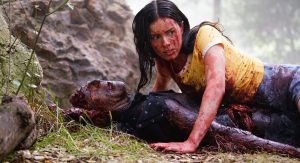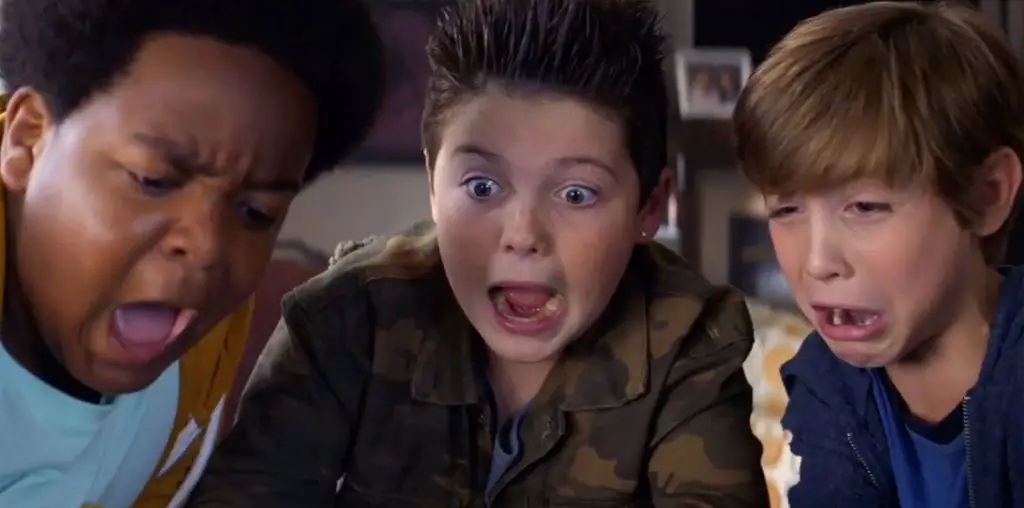
Nightmare Cinema centers on an ominous theater run by the mysterious Projectionist (Mickey Rourke). When an unsuspecting patron enters the auditorium, a movie based on their deepest fears plays on the screen. Samantha (Sarah Elizabeth Withers) takes a seat in the empty theater and The Thing In The Woods, written and directed by Alejandro Brugués, begins.
A few friends head to a cabin for a getaway. However, things turn deadly when an object falls from the sky. Now, the school chums are killing one another. What caused such a sudden change in their demeanor?
Brugués brings a lot of fun energy to the first entry here. It opens with Samantha attempting to get away from someone dressed as a traditional slasher. However, the reveal of who this person is and what they are doing is a clever subversion of genre tropes. This piece boasts energetic editing, with the pace never letting up. The cinematography is also great, with lots of bold colors and frantic camera zooming all over.
On the downside are the characters. Samantha is the only one whose name I recall, and even then, she is one dimensional. As such, while there is a lot to enjoy about this opening story, it is difficult to feel entirely invested.
Next is Joe Dante’s Mirari, written by Richard Christian Matheson. Anna (Zara Mahler) is self-conscious about a facial scar from a car accident. Her supportive significant other David (Mark Grossman) unsuccessfully tries to convince her that looks aren’t everything. But knowing how much it bothers Anna, David gets her an appointment with famed plastic surgeon Dr. Mirari (Richard Chamberlain). The initial surgery goes well, but small issues, such as trouble breathing, crop up. More operations are needed to fix these problems, so from the first time under the knife until days later, Anna’s bandages are always on. What are David and the doctor truly planning?

“…centers on an ominous theater run by the mysterious Projectionist…unsuspecting patron enters the auditorium, a movie based on their deepest fears plays on the screen.”
The writing for the characters in this segment is superb. Everyone has strong motivations for doing what they do, and the cast is having a ball with these meaty parts. As with the best of Dante’s work, dark humor is abundant throughout.
The director keeps the endgame a mystery until the last possible second. The reveal of what’s going on is both horrifying and absurd. For my money, this is the best segment of Nightmare Cinema.
Mashit is about hypocrisy at a Catholic school. Father Benedict (Maurice Bernard) and Sister Patricia (Mariela Garriga) are conducting an illicit affair. For all the teachers, nuns, and priests talk of the love of God, they often turn their back on those being bullied. Perhaps this is how an evil entity comes to start possessing the children. Father Benedict searches desperately for a way to stop the demon before the body count gets any higher.
Penned by Sandra Becerril, Mashit is a standard demon story with a few interesting elements thrown in to keep things lively. The story makes the most of its religious setting, which gives the whole production fantastic atmosphere. Under Ryûhei Kitamura’s direction, the film manages to be unnerving at every turn. Sometimes an old story told well is all you need.
After Mashit but before the next section, there is a flub. See, each time the customer leaves- be they dead or alive- the audience sees the new person(s) enter the building. Each time the marquee changes to the name of the next segment. That does not happen here. Before and after This Way To Egress, the marquee still says Mashit. As such, I suppose it is possible that I have reversed the segment titles.
This Way To Egress is David Slade’s contribution to the anthology. Helen (Elizabeth Reaser) has been waiting for hours to see a therapist. Things are made more stressful as her two sons are hungry and irritated at how long they’ve been there. The doctor finally gets around to Helen, and she explains the emergency.
Helen is seeing people not as they look but as deformed, dirty entities. The buildings and rooms she occupies are also grimy in a way she finds hard to express. The doctor proves unhelpful, and she leaves. However, upon exiting the doctor’s office, her children are missing. As Helen runs through the building searching for her family, debris and dirt pile up. What is happening to the world around her? Where are her kids?
Slade and Lawrence C. Connolly’s script has a great idea, but there is a flaw in its execution. The problem lies in not knowing enough about Helen before the start of the segment. To be able to feel her confusion over what she sees and her mental state, how this movie’s universe operates needs to be understood. Such a thing is not possible in a film like this, by the very nature of an anthology film.

“Such a thing is not possible in a film like this, by the very nature of an anthology film.”
What does work wonders here is Reaser. She owns every scene and makes Helen’s vulnerable state believable. The cinematography by Tony Kearns creates a haunting, phantasmagorical world. Plus, while there needs to be more in the beginning, how it ends is excellent.
The final part, Dead, is Mick Garris’s full-on segment, excluding the wraparound. It follows young music prodigy Riley (Faly Rakotohavana), who is near-fatally mugged. At the hospital, while recovering, no one is telling him what happened to his parents. Riley is also seeing random people in the hallways. Did the traumatic event cause him to see things? Is this his own personal hell?
Rakotohavana is perfection in the role. He sells Riley’s confusion, heartache, and fear amazingly. The supporting cast is wonderful as well, especially Cleo Fraser as another patient. The two play off each other nicely and feel like real teens caught in an unbelievable situation.
Garris frames each scene to maximize the creep factor. Dead is easily the scariest of all the segments. A moment that has Riley hiding with a dead body is a nail biter. The ending feels like adherence to horror movie law versus the logical conclusion to this particular story. That proves quite frustrating, but given that the conceit of the anthology is watching your fears play out, it is a bit more understandable here.
Nightmare Cinema brings together titans of the horror movie genre for one project exploring the dark side of life. While there are flaws in some of the segments, it is overall a fantastic production that manages to be creepy as hell. For fans of anthologies, these directors, and horror in general, this is a great ride.

Nightmare Cinema (2019) Directed by Mick Garris, Joe Dante, David Slade, Ryûhei Kitamura, Alejandro Brugués. Written by Mick Garris, Sandra Becerril, Alejandro Brugués, Lawerence C. Connolly, Richard Christian Matheson, David Slade. Starring Mickey Rourke, Sarah Elizabeth Withers, Elizabeth Reaser, Maurice Bernard, Faly Rakotohavana, Eric Nelsen, Patrick Wilson.
9 out of 10 Shivers



Looks interesting. I like anthologies especially horror.
Is that Maurice Benard the same guy who plays “Sonny” on General Hospital? If so…..about damn time he stretched his damned wings!
Always ready to see more of Richard Christian Matheson’s work – such brilliant edge-of-your-seat characterizations… congrats on this slate – sounds awesome… deliciously terrifying.